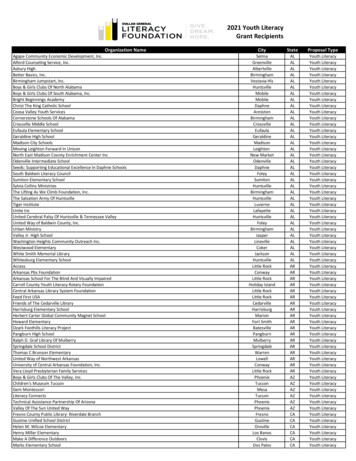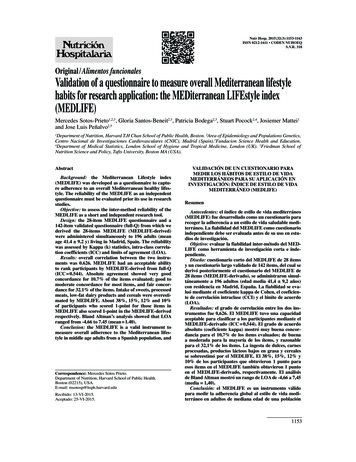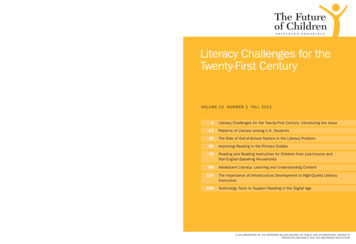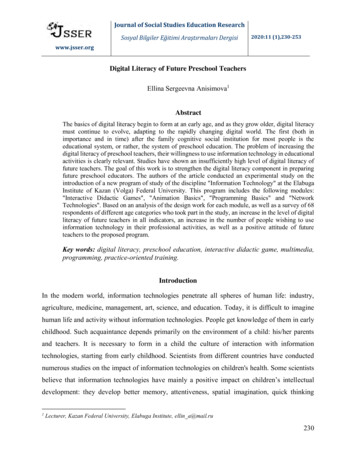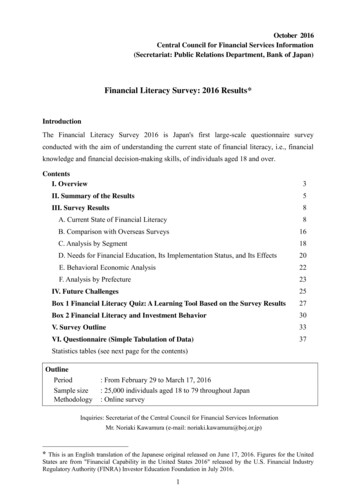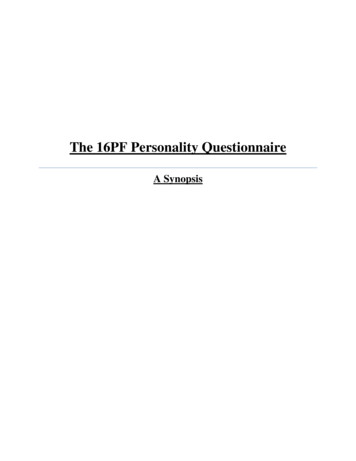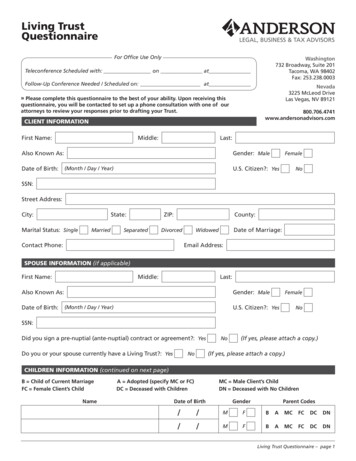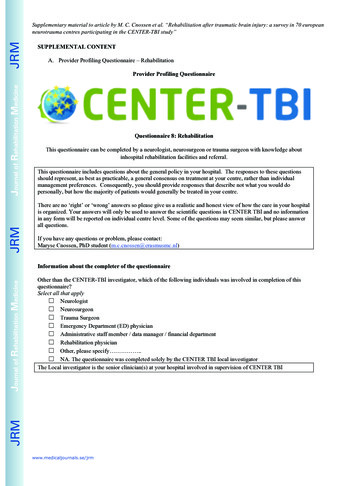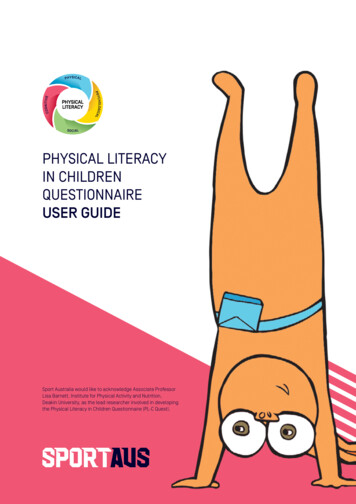
Transcription
PHYSICAL LITERACYIN CHILDRENQUESTIONNAIREUSER GUIDESport Australia would like to acknowledge Associate ProfessorLisa Barnett, Institute for Physical Activity and Nutrition,Deakin University, as the lead researcher involved in developingthe Physical Literacy in Children Questionnaire (PL-C Quest).
CONTENTSINTRODUCTION. 2PHYSICAL LITERACY IN AUSTRALIA. 2WHY THE INSTRUMENT WAS DEVELOPED. 3PROCESS OF DEVELOPING THE QUESTIONNAIRE. 4DEVELOPMENT OF THE CHARACTER. 4DEVELOPMENT OF SCENARIOS . 4HOW TO USE THE PHYSICAL LITERACY IN CHILDREN QUESTIONNAIRE. 5WORKING TOGETHER. 5ADMINISTRATOR INSTRUCTIONS. 6Questionnaire for younger children. 6Scoring for younger children. 7Questionnaire for older children. 8Scoring for older children . 9What the scores mean. 9APPENDIX 1 – COLDER CLIMATE COUNTRIES .10APPENDIX 2 – EXPERT WORKING GROUP. 11Artist background. 12APPENDIX 3 – PHYSICAL LITERACY FOR CHILDREN QUESTIONNAIRE: SCORING SHEET. 13APPENDIX 4 – PHYSICAL LITERACY ELEMENTS.16APPENDIX 5 – SUMMARY OF PHYSICAL LITERACY SCORES.16REFERENCES. 171
INTRODUCTIONThe Physical Literacy in Children Questionnaire (PL-C Quest) has been developed to help researchers, those working in thesport sector, coaches and teachers understand a child’s level of physical literacy. Understanding how a child perceives theirlevel of physical literacy will help inform programs that are most suitable in supporting our children on their physical literacyjourney, thereby increasing a child’s chance of being physically active for life.PHYSICAL LITERACY IN AUSTRALIAIn 2017, Sport Australia led an extensive consultation process with experts and relevant stakeholders 1 to develop a definitionof physical literacy for Australia 2,3. The Australian Physical Literacy Framework (the Framework) was released in August 2019 4.Physical literacy was characterised as the integration of physical, psychological, social and cognitive capabilities that helpus live active, healthy lifestyles 4. The Framework includes 30 elements across four domains – physical, psychological, socialand cognitive.DOMAINSELEMENTSDeveloping physicalliteracy involvesholistic learningthrough each of thefour domains.Each domain is made up of elements.These elements are the required skills,knowledge and behaviours thatenable development of physical literacy.PHYSICALThe skills andfitness a personacquires and appliesthrough movementPSYCHOLOGICALThe attitudes andemotions a person hastowards movement andthe impact they haveon their confidence andmotivation to moveSOCIALA person’s interactionwith others in relationto movementCOGNITIVEA person’sunderstandingof how, why andwhen they move Movementskills Moving withequipment Objectmanipulation Coordination Stability/balance FlexibilityAgilityStrengthMuscularendurance Cardiovascularendurance Reaction time Speed Engagement & enjoymentConfidenceMotivationConnection to placeSelf perceptionSelf regulation (emotions)Self regulation (physical) RelationshipsCollaborationEthicsSociety & culture Content knowledgeSafety & riskRulesReasoningStrategy & planningTacticsPerceptual awarenessFIGURE 1: AUSTRALIAN PHYSICAL LITERACY FRAMEWORK - AT A GLANCE2
WHY THE INSTRUMENT WAS DEVELOPEDWith the Framework being internationally recognised and with a nationally delivered sport in schools program, it wasimportant to start gathering information on the physical literacy levels of Australian school-aged children. Understandingwhere children are on their physical literacy journey will help to know how to support young people, thereby increasing thechances of a child being physically active for life.Physical literacy assessment could be used to:determine theeffectivenessof sport andphysical activityinterventionshelp measureGovernmentinitiativesdetermine theeffectivenessof teachinginitiativesmeasurepopulation levelsof children'sphysical literacytrack children’sprogress overtimeunderstand howa child viewstheir physicalliteracy in orderfor teachers anddeliverers tobetter planMeasuring physical literacy can be done in a number of ways. It can involve the whole construct of physical literacy (all fourdomains), individual domains (such as the physical domain), or even single elements of the construct (movement skills aspart of the physical domain). While other measurement tools can assess domains such as the physical and psychological,there is no single assessment tool that captures all 30 elements of the Framework 5.Some of the physical literacy elements, although important, are difficult to measure objectively (e.g. ‘connection to place’in the psychological domain). Therefore, the tool was developed so children could self-report how they see themselves.Self-reporting is important as systematic review evidence shows that how a child perceives themselves relates to theirphysical activity behaviour 6. Developing one consistent way to assess each element was also important in gaining acomprehensive understanding of a child's physical literacy.As the scale was developed in Australia, the scenarios relate to land and water-based experiences. Nevertheless, researchersand practitioners from other countries may choose to use the scale as most of the situations will translate to other cultures.For those from colder countries, input from an expert in Finland, helped to provide alternative scenarios for two of theelements from the Australian tool. Ice skating is substituted as an activity in the 'moving with equipment' element andtobogganing is substituted as an activity in the 'safety and risk' element (see Appendix 1). It is encouraged that the tool isused by those in different cultures to see how well scores represent the physical literacy of diverse samples of children andalso to provide consistency on a global level, due to comparable data.3
PROCESS OF DEVELOPING THE QUESTIONNAIREIn 2019, Sport Australia contracted Associate Professor (A/Prof) Lisa Barnett and her team from Deakin University (seeAppendix 2), to develop the instrument. A/Prof Lisa had expertise in developing pictorial scales 7,8 and was one of the leadresearchers in developing the Framework. The expertise and experience that A/Prof Lisa provided were vital in developinga comprehensive and accurate instrument.The project brief was to develop a self-report pictorial scale, with accompanying words, to assess physical literacy inschool age children (from 4 to 12 years). Deakin University established an expert reference group to contribute to thisprocess. Representatives had expertise in physical literacy, physical activity, sedentary behaviour, motor skill development,sport, education and health (see Appendix 2). Through the leadership of A/Prof Lisa Barnett, the expert working group wereconsulted during workshops and via email, providing extensive input into development of the instrument.DEVELOPMENT OF THE CHARACTERMelbourne based artist, Rebecca Stewart, was recruited to draw the character and images required. It wasimportant that the character did not depict a particular gender, race or ethnicity. That way boys, girls and childrenfrom a range of cultures and countries could identify with the character and use the instrument effectively.Testing with children occurred with three different characters to determine which character best met the brief.It was also important that the character was appealing to both boys and girls. As such, a cartoon creature,similar to a bunny was selected.Careful consideration was provided to the colour of the character. The character again needed to be inclusive ofdifferent genders, race and ethnicity. Therefore, a blue or pink character was not considered, as those coloursare typically identified with boys and girls.DEVELOPMENT OF SCENARIOSEach scenario was developed based on the literature and the knowledge of the expert working group. Given that the multiplediverse experiences of a child potentially contribute to them being more physically literate, it was considered important toprovide a diverse range of physical experiences. As a result, the 30 scenarios developed by the expert working group includeda broad range of: contexts, such as land and water (ice or snow) settings that were unstructured and structured locations, such as being at home or at school experiences/activities, such as playing a ball game or building a cubby.Providing a diverse range of physical experiences reflects the expansive intent of the construct of physical literacy, as definedby the Framework.The artist was briefed on the intention for each scenario, and she developed rough versions for each. The rough versions weretested with children to see if they understood the intended construct for each scenario. Children were first asked what theythought was happening in the images, then the words that accompany each image were read out loud by the administrator.The images were not designed to ‘stand-alone’; rather they were designed to be accompanied by text. Provided most childrenunderstood the intent of the scenario once the words were read aloud, then the brief was met.Some of the rough scenarios were better understood by the children than others. This feedback on the roughs from childrenwas combined with feedback from the expert working group members and the artist was briefed and changed the relevantscenarios accordingly. Sometimes these changes were minor additions to the drawings for clarity (e.g. placement of a ballor movement lines to indicate speed) and sometimes scenarios needed to be redrawn in a different context (e.g. using adifferent game or background setting). Finally, colour was carefully chosen for each scenario to ensure that the character wasvisible and stood out from the background. Read more about the development of the scale in our published paper9.4
HOW TO USE THE PHYSICAL LITERACYIN CHILDREN QUESTIONNAIREThe instrument can be used in the following ways:1.Younger childrenKindergarten/Prep to Grade 2 - approximately 4 to 8 year oldsAdministrator/teacher guides the child through the questionnaire during a face-to-face session.2. Older childrenGrade 3 to 6 – approximately 8 to 12 year oldsAdministrator/teacher reads each scenario out loud and guides a group of children through a self-completion process.WORKING TOGETHERWhile extensive development has occurred in terms of the scenarios to represent the 30 physical literacy elements of interest,this is only the first step in developing an instrument of this type9. Researchers and industry are encouraged to use theinstrument (PL-C Quest) with primary school children so further validation can be completed. Working together to measure achild’s level of physical literacy to inform program interventions is encouraged.To collaborate on projects, share findings, or if you have any queries or feedback, please contact Sport Australia,email physical literacy@sportaus.gov.auPlease contact A/Prof Lisa Barnett, Deakin University, if you would like to contribute data from your use of the instrumenttowards psychometric investigation of the tool. Deakin University have developed an online version of this instrument andaccess can be provided upon request. Please note, Deakin University collects the data from the online tool and thereforeethics approval and applicable data access would need to be prearranged. For collaboration on research projects and/oraccess to the online tool please contact A/Prof Lisa Barnett, Deakin University, email lisa.barnett@deakin.edu.au5
ADMINISTRATOR INSTRUCTIONSUse the below administrator instructions to guide you through the process of measuring a child’s physical literacy.QUESTIONNAIRE FOR YOUNGER CHILDRENUse this questionnaire for children in kindergarten/prep to grade 2 – approximately 4 to 8 year olds. This is to be completed inan individual face-to-face session. Please note, the questionnaire is to be printed single-sided, in colour and secured in thetop left corner.Administrator to instruct the child as follows: “I have something here that’s kind of like a picture game. In each picture, there is an orange cartoon bunny that is doingdifferent activities. Like this one here:I will read out words that go with the pictures and then I’m going to ask you to pick the picture each time where you thinkthe bunny character is being the most like you if you were in that situation.” “There is no right or wrong answer, we just want to see what you think about yourself.” “This is an example so you get the idea of what to do. Some children want to read books” (administrator points to thepicture on the child’s left). “Other children do not want to read books” (administrator points to picture on the child’s right). “Which is more like you?” After the child has pointed to the picture appropriate for him/her, the administrator asks, “Is this picture a LOT like you”(administrator points to the larger circle) “or a LITTLE bit like you?” (administrator points to the smaller circle).” “Do you understand what to do now?”Tip: Occasionally a child will point to the middle of the two pictures and say that both are likethem. The administrator should then say, “Yes sometimes we do feel both ways, but if you hadto pick, which one of these pictures shows the way you are most of the time.”6
SCORING FOR YOUNGER CHILDRENIf the child picks the more developed image on left, they will either get a score of ‘4’ if they said the picture was a LOT likethem, or a score of ‘3’ if they said the picture was a LITTLE bit like them.If the child picks the less developed image on the right, they will either get a score of ‘2’ if they said the picture was a LITTLEbit like them or a score of ‘1’ if they said the picture was a LOT like them.Record the child’s score using the Physical Literacy for Children Questionnaire: Scoring Sheet in Appendix 3.The administrator continues for each scenario/physical literacy element, reading the wording out loud that accompanieseach picture, verbatim, as he/she points to the picture accompanying each description.Example showing scores for each response:Some children want toread booksOther children do notwant to read booksA LOTlike meA BITlike meA BITlike meA LOTlike me43217
QUESTIONNAIRE FOR OLDER CHILDRENUse this questionnaire for children in grades 3 to 6 – approximately 8 to 12 year olds. It can be completed as a groupassessment. Please note, the workbook is to be printed in colour and single sided for easier use.Administrator to instruct the children as follows: “I have a booklet here that we are going to complete all at the same time. In each picture there is an orange bunny cartooncharacter that is doing different activities. Like this, which is on the front page:I will read out words that go with the pictures and then I’m going to ask you to pick the picture each time where you thinkthe cartoon character is being the most like you if you were in that situation.There is no right or wrong answer, we just want to see what you think about yourself.This is an example, so you get the idea of what to do”. “Some children want to read books” (have a look at the picture on the left of the first page), “Other children do not want toread books” (have a look at the picture on the right of the first page). “Which is more like you?” “Has everyone worked out which picture is more like them?” “Now you have to look at the picture you have chosen and decide if the picture is a LOT like you or a LITTLE bit like you?Once you have decided, put a cross in the box. You can only mark one box per page.”Example question:Some children want toread booksOther children do notwant to read booksA LOTlike meA BITlike meA BITlike meA LOTlike me8
“Wait a moment while I walk around and check you all know how to do it.” This is important to do as sometimes childrenthink they need to put an answer for both pictures, so you must visually check they know how to complete it. “Do you understand what to do now?”Like the younger children version, occasionally a child will point to the middle of the two pictures and say that both are likethem. The administrator should then say: “Yes sometimes we do feel both ways, but if you had to pick, which one of thesepictures shows the way you are most of the time.”The administrator continues for each element, reading the wording out loud, verbatim, as the children complete the workbook.Tip: Remind children to check only one box per scenario/page. It is also helpful to haveanother administrator in the room walking around and checking children are completing thequestionnaire correctly.SCORING FOR OLDER CHILDRENChildren record their responses in the workbook, as outlined above, and the administrator collates the responses using thePhysical Literacy for Children Questionnaire: Scoring Sheet at Appendix 3.A LOT like meA BIT like me43REMEMBER to check only ONE of the four boxesSome children want toread booksBUTA BIT like meA LOT like me21Other children do notwant to read booksWHAT THE SCORES MEANEach question relates to one of the 30 physical literacy elements (see Appendix 4). Create a total physical literacy score bytallying the responses for each question, using the Summary of Physical Literacy Scores at Appendix 5.Alternatively, you can tally the responses by domain. The score range for each of the domains is: Physical domain 12 to 48 Psychological domain 7 to 28 Social domain 4 to 16 Cognitive domain 7 to 28Currently, there is no interpretation of what a good or acceptable physical literacy score is. Although, the higher the score themore physically literate a child is. Please see the working together section of this manual for opportunities to contribute tothis work.We hope you enjoy using the Physical Literacy for Children Questionnaire (PL-C Quest) and thatit helps inform practices to improve children’s physical literacy.9
APPENDIX 1 – COLDER CLIMATE COUNTRIESTo ensure the instrument covered colder contexts outside of Australia, i.e. snow and ice, the following two additionalscenarios were developed: Ice skating scenario could replace the skateboarding scenario (question 2) which represents the ‘moving with equipment’element. Tobogganing scenario could replace the swimming at the beach scenario (question 30) which represents the ‘safety andrisk’ element.The drawing of these scenarios was kept as close as possible to the original Australian scenarios, which had been tested withchildren. For instance, the ice skating scenario still has the less competent character holding a support, which is how thecharacter was represented in the skateboarding image. The toboggan scenario shows two different places/paths to toboggan.One is visibly safer than the other, which is similar to how the beach scenario was represented.These two scenarios were chosen for replacement after consultation with Adjunct Professor Arja Sääkslahti, a seniordepartmental researcher at the Faculty of Sport and Health Sciences in the University of Jyväskylä, Finland. Adjunct ProfessorArja has multidisciplinary expertise in research on physical activity and motor skills in young children and designing familyand childcare based physical activity and motor skill interventions for young children. Adjunct Professor Arja has alsodeveloped pictorial scales for young children 9.Adjunct Professor Arja advised that ice skating was more applicable than skateboarding and that the beach context was notas relevant to the colder northern hemisphere countries. The new images were circulated amongst the expert working groupfor feedback and the drawings went through rounds of roughs as had the previous scenarios. The wording for the alternatescenarios is below.2.Some children are prettygood at ice skatingBUTOther children are not sogood at ice skating30.Some children thinkabout where it is safe totobogganBUTOther children do notthink about where it issafe to toboggan10
APPENDIX 2 – EXPERT WORKING GROUPTABLE 1: DEAKIN UNIVERSITY LEAD DEVELOPMENT TEAMNameInstitution and affiliationA/Prof Lisa BarnettInstitute of Physical Activity andNutrition, School of Health and SocialDevelopment, Deakin UniversityRelevant areas of expertise Lead investigator on the development of physicalliteracy definition and framework for Australia Development of pictorial scales for children Physical self-perception in children and youth Physical activity and motor competenceDr Natalie LanderStrategic Research Center, Research forEducational Impact (REDI), Faculty ofArts and Education, Deakin University Educational research Implementation science Physical activity and sedentary behaviour Actual and perceived motor competence and link tohealth behaviours and outcomesProf Jo SalmonInstitute of Physical Activity andNutrition, Deakin University Assessment of children’s physical activity Interventions to promote children’s physical activityand reduce sedentary behaviour Implementation and scale-up of interventionsDr Emiliano MazzoliSchool of Exercise and NutritionSciences, Deakin University Cognitive functioning and brain activity Motor skill and fitness assessment and intervention Actual and perceived motor competence assessmentDr Melanie HawkinsSchool of Health and SocialDevelopment, Deakin University Validity testing theory Health literacyTABLE 2: MEMBERS OF THE EXPERT WORKING GROUP (IN ALPHABETICAL ORDER) LED BY DEAKIN UNIVERSITYNameInstitution/sDr Trent BrownAustralian Council for Health, PhysicalEducation and Recreation (ACHPER) –VictoriaRelevant areas of expertise Physical education Professional learning Teacher education Physical activity and healthProf John CairneyUniversity of Queensland Physical literacy Children’s development Motor disorders in children Physical activity and health Measurement design and evaluation Behavioural interventionMs Sallee CaldwellSport Australia Physical literacy application and design Participation strategy and design Physical educationMr Pierre ComisSport Australia & Special Olympics Design and delivery of sport participation strategies,programs and products Physical literacy application in a systems approach Special populations – intellectual disabilitiesand autismDr Dean DudleyMacquarie UniversityThe University of the South Pacific Lead investigator on the development of physicalliteracy definition and framework for Australia Physical and health literacy Physical education pedagogy and assessment11
NameInstitution/sA/Prof RichardKeeganUniversity of CanberraRelevant areas of expertise Lead investigator on the development of physicalliteracy definition and framework for Australia Psychologist and motivation researcher Experienced in qualitative and quantitative methodsMr Gareth LongSport Australia & The Australian Collegeof Physical Education Physical education Initial teacher education Physical literacy program design Coach educationProf David LubansUniversity of Newcastle Design, evaluation, dissemination of school-basedphysical activity interventions Effects of physical activity and fitness on cognitiveand mental health Health and physical education pedagogy Movement skill competency in youthDr Natasha SchranzPrevention & Population HealthDirectorate, Wellbeing SA; Universityof South Australia, School of HealthSciences (Adj) Physical activity and sedentary behaviour Researcher involved in the development of the SportAustralia Physical Literacy FrameworkARTIST BACKGROUNDThis project relied heavily on the skills and expertise of a Melbourne based artist, Rebecca Stewart. Rebecca worked in the1990s in Melbourne’s 2D animation industry on short films, ads and TV shows. She graduated from the Victorian College of theArts with a Post Graduate Diploma of Film & TV (Animation) in 1998, then went on to teach character animation at Ngee AnnPolytechnic in Singapore. She works on book and magazine editorials, t-shirt design and character development. See more ofRebecca’s work.12
APPENDIX 3 – PHYSICAL LITERACY IN CHILDRENQUESTIONNAIRE: SCORING SHEETDate:Child’s name:ID:School/Club:Grade/class:Date of birth:Age:Gender (circle): Male / Female / Non-binary / Prefer not to sayPhysical domain: How good are you at.?A LOTlike meA BITlike meREMEMBER to check only ONE of the four boxes1.Some children are prettygood at hoppingBUTOther children are not sogood at hopping2.Some children are prettygood at skateboardingBUTOther children are not sogood at skateboarding3.Some children are prettygood at overarm throwingBUTOther children are not sogood at overarm throwing4.Some children are prettygood at running for a longtime without getting tiredBUTOther children are not sogood at running for a longtime without getting tired5.Some children are prettygood at hanging for a longtime without letting goBUTOther children are not sogood at hanging for a longtime without letting go6.Some children are prettygood at doing lots of jumpswith a skipping rope withoutgetting a leg caughtBUTOther children are not sogood at doing lots of jumpswith a skipping rope and geta leg caught7.Some children are prettygood at balancing on a rockand not wobblingBUTOther children are not sogood at balancing on a rockand start to wobble8.Some children are prettygood at touching their toeswithout bending their kneesBUTOther children are not sogood at touching their toesand bend their knees9.Some children are prettygood at dodging other kidsin a gameBUTOther children are not sogood at dodging other kidsin a game10.Some children are prettygood when strong musclesare needed, like whenpicking up a big rockBUTOther children are not sogood when strong musclesare needed, like whenpicking up a big rock11.Some children are prettygood at running straightaway when they hear thestarting gunBUTSome children are not sogood at running straightaway when they hear thestarting gun12.Some children are prettygood at running very fastBUTOther children are not sogood at running very fastA BITlike meA LOTlike me13
Psychological domain: How do you feel about.?A LOTlike meA BITlike meREMEMBER to check only ONE of the four boxesSome children feel likebeing active and playingsport whenever they can, forlots of reasons13.Some children feel they cancontrol their disappointmentwhen they miss the target14.BUTA BITlike meA LOTlike meA BITlike meA LOTlike meOther children do not findany good reasons for beingactive and playing sportBUTOther children do not feelthey can control theirdisappointment when theymiss the target15.Some children feel they canpace themselves to get upthe top of a hillBUTOther children do not feelthey can pace themselvesto get up the top of a hill16.Some children feel theyhave a pretty good idea oftheir own abilityBUTOther children sometimesthink they are better thanwhat they are17.Some children feelconfident to try new activethings, like taking off on azip-lineBUTOther children do not feelconfident to try new activethings, like taking off on azip-line18.Some children feel theylike being active in lots ofdifferent ways, becausethey enjoy itBUTOther children do not feellike being active in lots ofdifferent ways, becausethey don’t enjoy it19.Some children feel theyhave favourite places tohang out and playBUTOther children do not feelthey have favourite placesto hang out and playSocial domain: Do you want to.?A LOTlike me20.21.22.23.A BITlike meREMEMBER to check only ONE of the four boxesSome children want toshake hands with kids fromthe other team after losinga gameSome children want to inviteother kids to play with themSome children want to joinin an activity or game wherethey can work togetherSo
us live active, healthy lifestyles 4. The Framework includes 30 elements across four domains - physical, psychological, social and cognitive. DOMAINS Developing physical literacy involves holistic learning through each of the four domains. ELEMENTS Each domain is made up of elements. These elements are the required skills,
